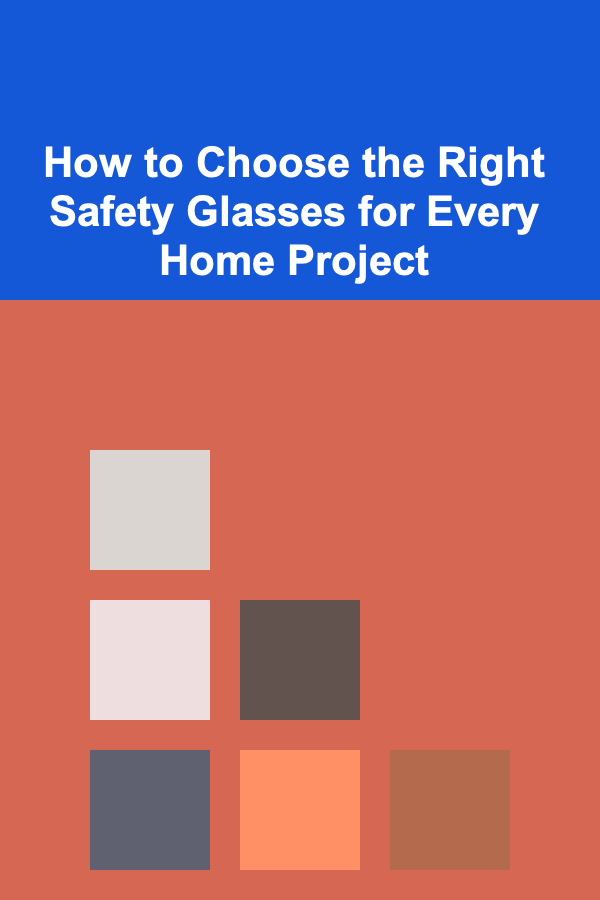
How to Choose the Right Safety Glasses for Every Home Project
ebook include PDF & Audio bundle (Micro Guide)
$12.99$7.99
Limited Time Offer! Order within the next:

Home improvement projects, whether big or small, can significantly enhance the value and comfort of your living space. However, these projects often come with inherent risks to your eyes. From flying debris to chemical splashes, the potential for eye injury is surprisingly high. Choosing the right safety glasses is not merely a suggestion; it's a critical step in protecting your vision and ensuring your well-being while tackling DIY tasks. This comprehensive guide will delve into the various types of safety glasses, relevant standards, factors to consider when selecting the appropriate eyewear, and project-specific recommendations to keep your eyes safe and sound.
Understanding the Risks to Your Eyes During Home Projects
Before diving into the specifics of safety glasses, it's essential to understand the diverse range of hazards that your eyes might encounter during common home improvement activities. Knowing these risks will inform your selection process and highlight the importance of adequate eye protection.
Common Eye Hazards in Home DIY Projects:
- Flying Debris: This is arguably the most common hazard. Sawing wood, drilling metal, sanding surfaces, or even hammering nails can propel small particles of wood, metal, plastic, or dust towards your eyes.
- Chemical Splashes: Cleaning solutions, paints, solvents, adhesives, and even everyday household cleaners can cause severe eye irritation or even chemical burns if they come into contact with your eyes.
- Dust and Particles: Fine dust particles, generated during sanding, demolition, or sweeping, can irritate the eyes, leading to discomfort and potentially long-term damage.
- Impact from Tools or Objects: While less frequent, the risk of being struck in the eye by a tool, falling object, or ricocheting nail or staple is a real possibility.
- UV Radiation: Welding, even on a small scale, emits harmful ultraviolet (UV) radiation that can cause serious eye damage, including photokeratitis (welder's flash). Even working outdoors on a bright day can expose your eyes to harmful UV rays.
- Heat: Working with soldering irons, heat guns, or near open flames can expose your eyes to extreme heat, potentially causing burns or discomfort.
Ignoring these hazards can lead to a range of eye injuries, from minor irritations to severe and permanent vision loss. Wearing appropriate safety glasses is a simple yet effective way to significantly reduce these risks.
Decoding Safety Standards: ANSI Z87.1 and Beyond
When shopping for safety glasses, you'll likely encounter the ANSI Z87.1 standard. This is a widely recognized American National Standards Institute (ANSI) standard that sets the criteria for safety eyewear performance. Understanding what this standard means is crucial for ensuring you're purchasing adequate protection.
ANSI Z87.1: The Foundation of Eye Protection
The ANSI Z87.1 standard covers various aspects of safety eyewear, including:
- Impact Resistance: This is the most critical aspect. The standard specifies requirements for both basic and high-impact resistance. High-impact eyewear is designed to withstand significantly greater force than basic-impact eyewear. Lenses and frames are tested to ensure they can withstand impacts from projectiles without shattering or dislodging.
- Penetration Resistance: This tests the lens's ability to prevent penetration by sharp objects.
- Optical Clarity: The standard requires lenses to have a certain level of optical clarity to minimize distortion and ensure clear vision.
- Coverage Area: Safety glasses must provide adequate coverage to protect the entire eye area from all angles.
- Flammability: Frames must meet specific flammability requirements to minimize the risk of ignition.
What to Look For: When purchasing safety glasses, look for the "Z87+" marking on both the lenses and the frames. This indicates that the eyewear meets the ANSI Z87.1 high-impact requirements. A simple "Z87" marking indicates basic impact protection.
Beyond ANSI Z87.1: Additional Considerations
While ANSI Z87.1 is the primary standard to look for, certain projects might require additional considerations:
- UV Protection: Look for safety glasses labeled with "UV400" or "100% UV protection." This indicates that the lenses block harmful ultraviolet rays.
- Specialized Lenses: Certain lenses are designed for specific tasks. For example, welding helmets with auto-darkening lenses provide protection from the intense light produced during welding.
- European Standards (EN 166): If purchasing eyewear manufactured outside the US, look for compliance with EN 166, the European standard for personal eye protection.
Types of Safety Glasses: A Comprehensive Overview
Safety glasses come in a variety of styles and configurations, each designed to offer different levels of protection and comfort for specific tasks. Understanding the different types will help you choose the most appropriate eyewear for your home projects.
Common Types of Safety Glasses:
- Safety Glasses (Spectacles): These are the most common type of safety eyewear. They resemble regular eyeglasses but are made with stronger materials and designed to meet ANSI Z87.1 standards. They offer good protection against impact and flying debris for general-purpose use.
- Pros: Lightweight, comfortable for extended wear, affordable, available in various styles.
- Cons: May not provide complete coverage from all angles, particularly around the temples and eyebrows.
- Best for: General DIY tasks, woodworking, light metalworking, gardening.
- Safety Goggles: Goggles provide a more secure and complete seal around the eyes, offering superior protection against dust, splashes, and fumes. They are ideal for tasks that involve a higher risk of these hazards.
- Pros: Excellent protection against dust, splashes, and fumes, secure fit.
- Cons: Can be less comfortable than safety glasses, may fog up, can restrict peripheral vision slightly.
- Best for: Sanding, grinding, demolition, working with chemicals, drywall work.
- Safety Face Shields: Face shields provide full-face protection against impacts, splashes, and sprays. They are often used in conjunction with safety glasses or goggles for added protection.
- Pros: Full-face protection, good visibility, protects against larger projectiles and splashes.
- Cons: Can be bulky, may not be suitable for tight spaces, offers no impact protection without glasses or goggles underneath.
- Best for: Woodturning, grinding, cutting metal, working with large amounts of liquids.
- Welding Helmets: Specifically designed for welding, these helmets provide protection against intense light, sparks, and radiation. They feature a dark lens that automatically darkens when an arc is struck, protecting the eyes from harmful UV and infrared radiation.
- Pros: Essential for welding, protects against harmful radiation, auto-darkening lenses improve visibility.
- Cons: Bulky, specialized for welding only.
- Best for: Welding, cutting with a plasma torch.
- Laser Safety Glasses: These specialized glasses are designed to protect the eyes from specific wavelengths of laser light. They are crucial when working with lasers for alignment or other tasks.
- Pros: Protects against specific laser wavelengths, essential for laser-related tasks.
- Cons: Highly specific to laser types, must be chosen carefully.
- Best for: Working with lasers.
- Reader Safety Glasses: Combines the impact protection of safety glasses with magnification for close-up work. Ideal for those who need reading glasses but also require eye protection.
- Pros: Combines safety with magnification, convenient for detailed work.
- Cons: Not suitable for tasks requiring distance vision.
- Best for: Detailed woodworking, electronics repair, any task requiring close-up vision and safety.
Key Factors to Consider When Choosing Safety Glasses
Selecting the right safety glasses involves considering several factors beyond just the type of eyewear. A proper fit, lens material, and specific project requirements all play a vital role in ensuring optimal protection and comfort.
Fit and Comfort:
- Proper Fit: Safety glasses should fit snugly and comfortably on your face without being too tight or too loose. They should not slide down your nose or pinch your temples. Adjustable features, such as nose pads and temple arms, can help customize the fit. A poor fit can compromise protection, as the glasses may shift during use, exposing your eyes to hazards.
- Comfort: You'll be more likely to wear safety glasses consistently if they're comfortable. Look for lightweight frames, soft nose pads, and flexible temple arms. Consider the ventilation features of goggles to minimize fogging.
- Compatibility with Other PPE: If you wear other personal protective equipment (PPE), such as a respirator or hearing protection, ensure that your safety glasses are compatible. They should fit comfortably and securely without interfering with the other equipment.
Lens Material:
- Polycarbonate: This is the most common lens material for safety glasses due to its high impact resistance, light weight, and optical clarity. It's a good choice for most DIY projects.
- Trivex: Similar to polycarbonate but with even greater optical clarity and slightly better impact resistance. It's a premium option for those who prioritize visual acuity.
- Glass: Offers excellent scratch resistance and optical clarity but is heavier and more prone to shattering than polycarbonate or Trivex. Less commonly used in modern safety glasses.
- Acrylic: Less expensive than polycarbonate but also less impact-resistant. Suitable for tasks with minimal impact risk.
Lens Coatings and Tints:
- Anti-Scratch Coating: This coating protects the lenses from scratches, extending their lifespan and maintaining optical clarity.
- Anti-Fog Coating: Essential for tasks performed in humid or temperature-changing environments, preventing fogging and ensuring clear vision.
- UV Coating: Blocks harmful ultraviolet rays, protecting your eyes from sun damage.
- Tinted Lenses:
- Clear: For general indoor use.
- Gray: Reduces glare and provides good all-around protection for outdoor use.
- Yellow/Amber: Enhances contrast in low-light conditions, improving visibility.
- Mirrored: Reflects sunlight, reducing glare in bright outdoor conditions.
- Welding Lenses (Shades 3-14): Required for welding, providing protection from the intense light and radiation.
Specific Project Requirements:
- Impact Resistance: Projects involving hammering, sawing, drilling, or grinding require high-impact-rated safety glasses (ANSI Z87+).
- Chemical Resistance: When working with chemicals, choose safety goggles or glasses with a chemical-resistant lens and frame.
- Dust Protection: For tasks that generate a lot of dust, such as sanding or demolition, opt for safety goggles with a close-fitting seal.
- UV Protection: If working outdoors, select safety glasses with UV protection to shield your eyes from the sun's harmful rays.
Project-Specific Safety Glass Recommendations
To further assist you in choosing the right safety glasses, here's a breakdown of recommendations for common home projects:
Woodworking:
- Tasks: Sawing, sanding, drilling, routing, woodturning.
- Recommended Eyewear:
- Safety Glasses (Spectacles): For general woodworking tasks with moderate impact risk.
- Safety Goggles: For sanding, woodturning, or tasks that generate a lot of dust.
- Safety Face Shield (in addition to glasses or goggles): For woodturning or other tasks with a high risk of flying debris.
- Lens Material: Polycarbonate.
- Lens Coating: Anti-scratch.
Metalworking:
- Tasks: Grinding, cutting, welding, drilling.
- Recommended Eyewear:
- Safety Glasses (Spectacles) with Side Shields: For general metalworking tasks.
- Safety Goggles: For grinding or tasks that generate a lot of sparks.
- Welding Helmet with Auto-Darkening Lens: Essential for welding.
- Safety Face Shield (in addition to glasses or goggles): For grinding or cutting metal.
- Lens Material: Polycarbonate.
- Lens Coating: Anti-scratch.
- Special Considerations: For welding, ensure the welding helmet has the appropriate shade lens for the welding process.
Painting and Staining:
- Tasks: Painting, staining, varnishing.
- Recommended Eyewear:
- Safety Glasses (Spectacles): For general painting and staining tasks.
- Safety Goggles: For spraying paint or working with solvents to prevent splashes.
- Lens Material: Polycarbonate.
- Lens Coating: Anti-scratch, anti-fog (if working in humid conditions).
Demolition:
- Tasks: Removing walls, floors, or other structures.
- Recommended Eyewear:
- Safety Goggles: Essential for demolition work to protect against dust, debris, and impacts.
- Safety Face Shield (in addition to goggles): Provides additional protection against larger debris.
- Lens Material: Polycarbonate.
- Lens Coating: Anti-scratch, anti-fog.
Gardening and Landscaping:
- Tasks: Mowing, trimming, pruning, planting.
- Recommended Eyewear:
- Safety Glasses (Spectacles): For general gardening tasks.
- Safety Goggles: For trimming or tasks that generate dust or debris.
- Lens Material: Polycarbonate.
- Lens Coating: Anti-scratch, UV protection.
Cleaning:
- Tasks: Cleaning with chemicals, pressure washing.
- Recommended Eyewear:
- Safety Goggles: Essential for cleaning with chemicals to prevent splashes and fumes from entering the eyes.
- Lens Material: Polycarbonate.
- Lens Coating: Anti-fog, chemical resistant.
Working with Power Tools:
Regardless of the specific power tool, always wear safety glasses or goggles when operating power tools. The risk of flying debris and impacts is significantly higher with power tools compared to manual tools.
Maintenance and Care of Safety Glasses
Proper maintenance and care of your safety glasses will extend their lifespan and ensure they continue to provide optimal protection. Here are some tips:
- Clean your safety glasses regularly: Use a mild soap and water solution or a specialized lens cleaning solution. Avoid using harsh chemicals or abrasive cleaners, as these can damage the lenses and coatings.
- Store your safety glasses in a protective case: This will prevent scratches and other damage when they're not in use.
- Inspect your safety glasses regularly: Check for scratches, cracks, or other damage. Replace your safety glasses if they are damaged, as they may not provide adequate protection.
- Replace scratched or damaged lenses: If possible, replace the lenses instead of the entire glasses to save money. However, ensure that the replacement lenses meet the same safety standards as the original lenses.
Conclusion: Prioritizing Eye Safety for Every Project
Protecting your eyes should be a top priority during any home improvement project. By understanding the risks involved, choosing the right safety glasses for the task, and maintaining your eyewear properly, you can significantly reduce the likelihood of eye injuries and enjoy your DIY projects with confidence. Remember to prioritize safety over cost, and invest in high-quality safety glasses that meet the relevant standards. Your vision is irreplaceable, and a little precaution can go a long way in preserving it for years to come.

How to Create DIY Family Board Games Together
Read More
How to Decorate a Fresh Christmas Tree from Home Depot with Ease
Read More
How to Make a Checklist for Safety Inspections in Schools
Read More
How to Refinance Your Mortgage to Save Money in the Long Run
Read More
How to Use Vintage Trunks for Stylish Luxury Item Storage
Read More
How To Identify Body and Texture in Wine
Read MoreOther Products

How to Create DIY Family Board Games Together
Read More
How to Decorate a Fresh Christmas Tree from Home Depot with Ease
Read More
How to Make a Checklist for Safety Inspections in Schools
Read More
How to Refinance Your Mortgage to Save Money in the Long Run
Read More
How to Use Vintage Trunks for Stylish Luxury Item Storage
Read More